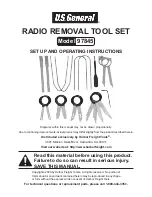
Page 33
Operator Manual
MB-280-02
All Seat Belt Types
Refer to additional details below for details applying to different types of seat belts.
Before fastening the seat belt:
•
If equipped with adjustable seats, adjust the seat to the position that suits you best.
•
Make sure the shoulder and/or lap belt is not twisted and freely passes through any guides.
To unfasten the belt, Push the release button on in the buckle.
Combination Lap and Shoulder Belts
While your vehicle is in motion, the combination lap and shoulder belt adjusts to your movement.
However, if you brake hard, corner hard or if your vehicle receives an impact of 5 mph (8 kph) or
more, the lap and shoulder belt locks and helps reduce your forward movement. The retractor can
also be made to lock by rapidly pulling on the belt.
To fasten the belt, pull the lap/shoulder belt from the retractor so that the shoulder portion of the
belt crosses your shoulder and chest. Insert the belt tongue into the proper buckle until you hear
a snap and feel it latch.
To unfasten the belt, Push the release button on in the buckle. This allows the tongue to unlatch
from the buckle. Guide the tongue to its stowed position while the belt retracts. If you do not guide
the tongue, it may strike you or part of the vehicle.
Lap Belts Only
With Auto Retractor:
To fasten the belt, pull the belt from the retractor and insert the belt tongue
into the proper buckle until you hear a snap and feel it latch. Make sure the tongue is securely
fastened in the buckle.
When unfastening the belt, guide the belt tongue to its stowed position. If you do not guide the
tongue, it may strike you or part of the vehicle.
Without Auto Retractor:
To fasten the belt, insert the belt tongue into the proper buckle until you
hear a snap and feel it latch. Pull the belt adjustor strap until the belt is snug against your lap.
After unfastening the belt, stow the belt in a position so that it cannot fall out of the vehicle while
the vehicle is in motion and the belt is not in use.
Seat Belts While Pregnant
If equipped with seat belts, always wear a seat belt. Wearing your seat belt protects you and your
baby from injury or death in the event of a collision. You should wear a seat belt no matter where
you sit in the vehicle.
Be sure to wear your seat belt correctly. The lap strap should go under your belly, across your hips
and as high as possible on your thighs. The shoulder strap should go between your breasts and
off to the side of your belly. Seat belt straps should never go directly across your stomach. The
seat belt should fit snugly.
Safety Belt Maintenance
Check the safety belt systems periodically to make sure that they work properly and are not damaged.
All safety belt assemblies, including retractors, buckles, front seat belt buckle support assemblies
and attaching hardware, should be inspected by a qualified technician after any collision.
Taylor-Dunn recommends that all safety belt assemblies used in vehicles involved in a collision
be replaced. However, if the collision was minor and a qualified technician finds that the belts do
not show damage and continue to operate properly, they do not need to be replaced. Safety belt
assemblies not in use during a collision should also be inspected and replaced if either damage
or improper operation is noted.
Summary of Contents for BT-280-36
Page 55: ...Index 55 ...
















































